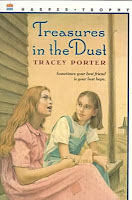Treasures in the Dust by Tracey Porter is a work of historical fiction. It is set right in the middle of the Oklahoma Dust Bowl during the Great Depression. This tells the potential reader right away that times are tough. But imagine if the dust storms are all you have ever known. You don't remember a time without dust and poverty. Suppose you see the sadness of the adults around you who remember a better time. Suppose you hear the amazing stories of the elderly who remember a time of plenty. But since you have known no different, you make your own kind of good.
Sometimes friendships are built upon mutual circumstances and not on similar interests. Meet eleven-year-old Annie. Her mother remembers the first day that Annie walked. It was the same day as the first dust storm. They have experienced dozens of them together since. Annie lives on a farm with her parents and her older brother. The farm is barely making it, but the family is determined to survive until the rains come to clear out the dust and drown the drought.
Meet eleven-year old Violet. She lives with her parents, twin siblings, baby brother and an elderly, blind aunt. They also have a farm, but it is even closer to ruin. The only thing keeping them on the farm is Aunt Miracle who suffers from Dust Pneumonia and is too weak to make the trip to the land of milk and honey - California. Violet is afraid that she will be made to stay at home and watch the twins instead of go to school.
Both girls have grown up in the middle of the Dust Bowl, however, they deal with their circumstances in very different ways. Annie has intelligence and common sense. Violet is a dramatic dreamer full of fairy dust and stories. Annie searches the dust for treasures like arrowheads from the Plains Indians. Violet pretends to be a princess of the Arabian Nights. Annie plans on becoming an archeologist while Violet wants to be a Hollywood actress.
This book is another epistolary like P.S. Longer Letter Later. At the beginning of the book, while both girls are still in Oklahoma, the chapters alternate between the poetic voices of the two girls. When Violet moves away with her family to find work in California, the girls write to each other and the chapters become alternating letters.
I will admit that this 2000 Caudill nominee was less memorable than others. But it depicts life during the Dust Bowl accurately as well as graphically. The only white spot left on your pillow in the morning was the space where your head was. Wires or ropes connected buildings so that during a dust storm you wouldn't get lost on your way to the barn or outhouse and back. Rags were stuffed into cracks to keep the dust out of the house. Families huddled under kitchen tables covered in blankets to ride out a storm. The roof and attics needed to be swept or shoveled lest they sag under the weight of the dust and collapse.
If you are interested in the Great Depression or the devastation left by the dust storms, this is a quick and easy read. I'm sure you will identify with one of the two girls or a combination of both. I happen to like the spunk of Aunt Miracle who has her own stories to tell!
Subscribe to:
Post Comments (Atom)


No comments:
Post a Comment